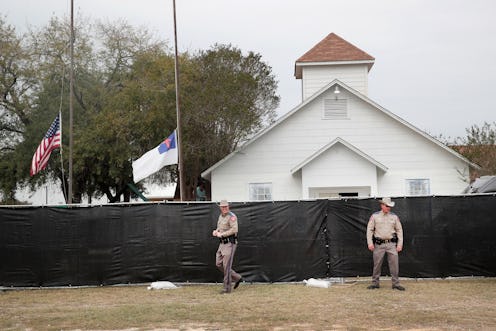News
The Texas Church Where The Shooting Happened Could Be Torn Down & Replaced With A Memorial

The small white church in Sutherland Springs, Texas, that was the site of a shooting massacre on Sunday might soon be torn down and replaced. The church's pastor, Frank Pomeroy, has reportedly discussed demolishing the Texas church in light of the shooting and replacing it with a memorial with national Baptist leadership.
“Since that building is the scene of so much horror, Frank said he had been thinking it was in the best interest of the church to have the worship center removed and the site turned into a memorial garden,” Roger Oldham, a spokesman for the Southern Baptist Convention’s Executive Committee said, according to The Washington Post. He continued, “The church has not yet voted, so there is no definitive plan.”
On Sunday, a shooter opened fire at First Baptist Church of Sutherland Springs, killing more than two dozen people. Pomeroy's teenage daughter, Annabelle, was among the victims. Pomeroy was out of town with his wife on the day of the tragedy.
The Post reports that several ideas about what to do with the building have been posed among church leadership. Ultimately, however, the future of the church's structure will need to be decided between Pomeroy and the church's congregants. In the meantime, leadership is reportedly focused on taking care of its grieving members.
While the fate of the building is uncertain, the congregation still plans to gather on Sunday, with Pomeroy presiding over services, according to The Daily Beast. There were nearly 100 regularly attending members at the church before the shooting. Twenty-six people died in the shooting, and more than 20 were injured.
Pomeroy reportedly told The Wall Street Journal that many folks "do not want to back in there." He is left grappling not only with his own grief, but with the grief of his congregation.
How to deal with sites of mass murder is always a contentious issue. Some surviving family members and friends would wish to see such places, which evoke painful memories, demolished. But community leaders are also put in a position of attending to the community as a whole.
People react to tragedy differently. For example, after the Columbine High School shooting in 1999, administrators were still in charge of a slew of students who needed to continue their educations. In that situation, school leaders opted to tear down the library where much of the devastation occurred and replace it with a new one. Similarly, much of the school underwent renovations.
But in the case of the Emanuel African Methodist Episcopal church in Charleston, South Carolina, where nine people were shot by a gunman in 2015, doors reopened within a week. There, congregants worked to foster a culture of resilience.
"We won’t give in to exclusion, we won’t give in to suspicion. We’ll seek to be prudent but we won’t be afraid," the church's Rev. Cress Darwin told Al Jazeera with regard to the church's first service after the shooting.
In the case of the Sandy Hook Elementary School in Newtown, Connecticut, where 26 children and school employees were killed, the community chose to raze the structure and build an entirely new school, but not after a heated community debate about the nature of memorials and how to move forward from violent tragedies. In the end, all traces of the school were reportedly erased, and no memorial was put in place when the new school building opened. Debris from the razing was also reportedly moved to a secret location before being completely destroyed.
Ultimately, when it comes to grieving and looking to the future, there is no right answer, and people must work together to find a solution that fits their specific situation.